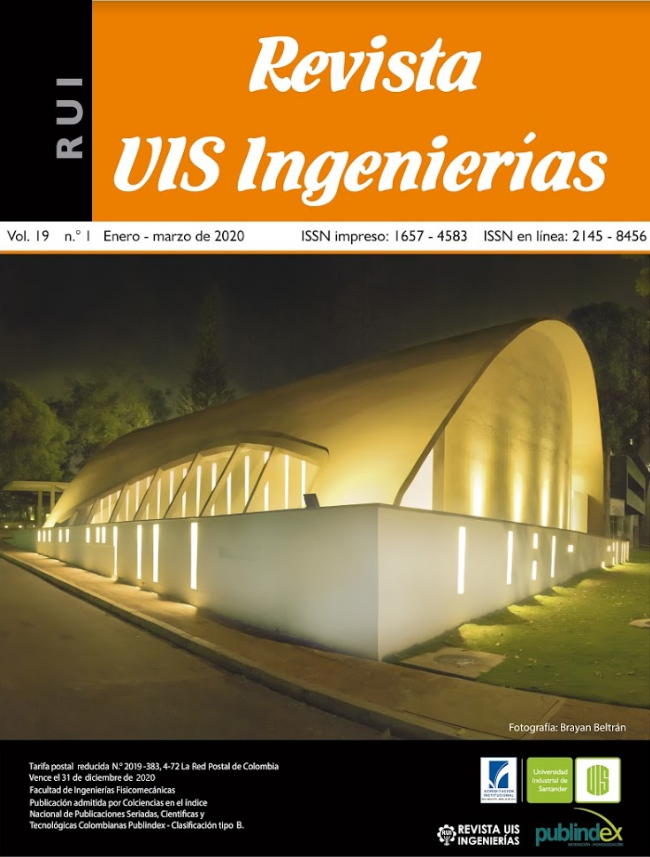Euler-Lagrange modelling for three-bladed rotors in wind turbines as a multibody system
Published 2019-10-31
Keywords
- Euler-Langrange,
- multibody dynamics,
- simulation,
- rotor,
- wind turbine
How to Cite
Copyright (c) 2020 Revista UIS Ingenierías

This work is licensed under a Creative Commons Attribution-NoDerivatives 4.0 International License.
Abstract
In order to develop strategies to maximize the utilization of wind power, it is necessary to have reliable models to simulate wind turbines’ responses. Manufacturers have detailed models, though these are “black box”, which makes them unusable even in new designs. Thus, so-called generic models have proliferated. Under this approach, this article presents dynamic modeling for a three-bladed rotor in a wind turbine using Euler-Lagrange formulation. For this analysis, the rotor is described as a multibody system with four degrees of freedom using simplified transformation matrices. The details of how the model was obtained and the interpretation of its three-dimensional (3D) simulation are presented using diverse conditions, which guarantees that the model’s reliability can be easily verified.
Downloads
References
[2] Bianchi, D. Battista, and Mantz, Wind turbine control systems: principles, modelling & gain scheduling design (Advances in industrial control) POD. Springer, 2006. doi: 10.1007/1-84628-493-7
[3] P. J. Schubel and R. J. Crossley, “Wind Turbine Blade Design,” in Wind Turbine Technology: Principles and Design, M. Adaramola, Ed. Apple Academic Press, 2014, pp. 1–34. doi: 10.1201/b16587.
[4] M. S. Maza, S. Preidikman, And F. G. Flores, “Aeroelasticidad Computacional De Grandes Aerogeneradores: Estado Del Arte, Desafíos Y Áreas De Vacancia,” Mecánica Comput., vol. 35, no. 25, pp. 7–10, 2017.
[5] K. C. Wu, “An approach to the development and analysis of wind turbine control algorithms,” Albuquerque, NM, and Livermore, CA (United States), Mar. 1998. doi: 10.2172/658292.
[6] M. Saleh, A. Nada, A. El-Betar, and A. El-Assal, “Computational Design Scheme for Wind Turbine Drive-Train Based on Lagrange Multipliers,” J. Energy, vol. 2017, pp. 1–16, 2017, doi: 10.1155/2017/4027834.
[7] M. K. Al-Solihat and M. Nahon, “Flexible multibody dynamic modeling of a floating wind turbine,” Int. J. Mech. Sci., vol. 142–143, pp. 518–529, 2018, doi: 10.1016/j.ijmecsci.2018.05.018.
[8] K.-P. Park, J.-H. Cha, and N. Ku, “The flexible multibody dynamics of a floating offshore wind turbine in marine operations,” Ships Offshore Struct., vol. 12, no. 4, pp. 563–574, May 2017, doi:10.1080/17445302.2016.1187373.
[9] Y. Li, A. M. Castro, T. Sinokrot, W. Prescott, and P. M. Carrica, “Coupled multi-body dynamics and CFD for wind turbine simulation including explicit wind turbulence,” Renew. Energy, vol. 76, pp. 338–361, 2015, doi: 10.1016/j.renene.2014.11.014.
[10] X. Jin, L. Li, W. Ju, Z. Zhang, and X. Yang, “Multibody modeling of varying complexity for dynamic analysis of large-scale wind turbines,” Renew. Energy, vol. 90, pp. 336–351, 2016, doi: 10.1016/j.renene.2016.01.003.
[11] A. P. Matus Vicente, M. Á. Hernández López, F. Aguilar Acevedo, and J. J. Arellano Pimentel, “Simulador Tridimensional De La Cinemática Del Rotor De Un Aerogenerador Tripala Con Base En La Convención D-H,” Pist. Educ., vol. 39, no. 128, pp. 1094–1107, 2018.
[12] msc software Corporation, “Adams - The Multibody Dynamics Simulation Solution,” mscsoftware, 2018. [Online]. Available: http://www.mscsoftware.com/product/adams. [Accedido: 3-oct-2018]
[13] DTU Wind Energy, “Welcome to HAWC2 (Horizontal Axis Wind turbine simulation Code 2nd generation),” HAWC2, 2018. . [Online]. Available: http://www.hawc2.dk/hawc2-info. [Accedido: 3-oct-2018]
[14] M. W. Spong, S. Hutchinson, and M. (Mathukumalli) Vidyasagar, Robot modeling and control. John Wiley & Sons, 2006.
[15] A. Barrientos, C. Balaguer, L. F. Peñin, and R. Aracil, Fundamentos De Robotica, 2nd Ed. Madrid Etc.: Mcgraw-Hill, 2007.
[16] A. P. Matus Vicente, “Simulador Tridimensional de la Cinemática del Rotor de un Aerogenerador Tripala,” Universidad del Istmo, 2017.
[17] The MathWorks Inc., “Troubleshoot Common ODE Problems,” mathworks, 2018. . [Online]. Available: https://www.mathworks.com/help/matlab/math/troubleshoot-common-ode-problems.html. [Accedido: 9-oct- 2018]
[18] J. Fortmann, Modeling of Wind Turbines with Doubly Fed Generator System. Springer Science+Business Media, 2015. doi: 10.1007/978-3-658-06882-0
[19] F. Baumjohann, M. Hermanski, R. Diekmann, and J. Kröning, “3D-multi body simulation of wind turbines with flexible components”, DEWI Magazin, no. 21, pp. 63-6, 2002. [Online]. Available: https://www.dewi.de/dewi_res/fileadmin/pdf/publications/Magazin_21/12.pdf

